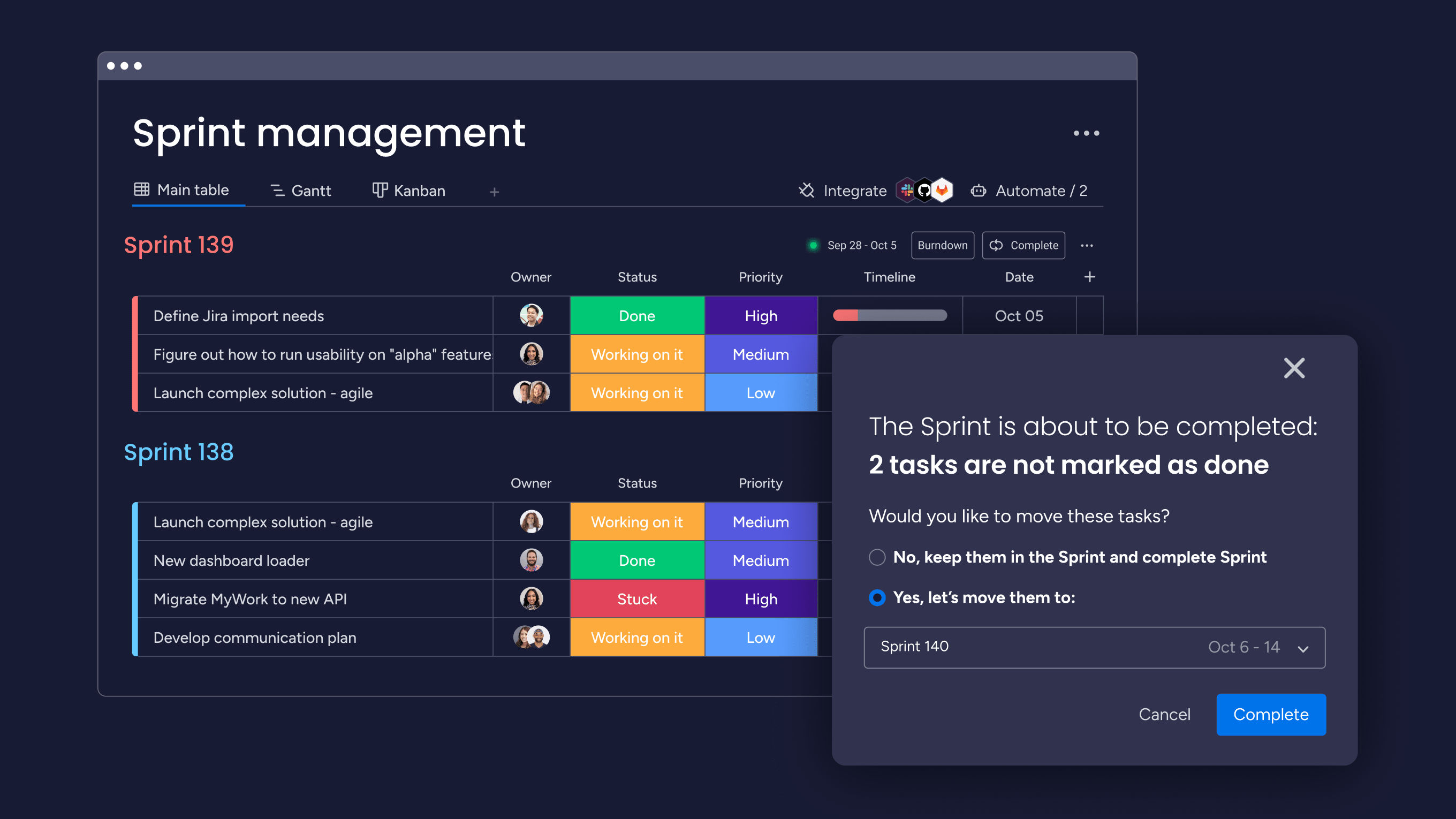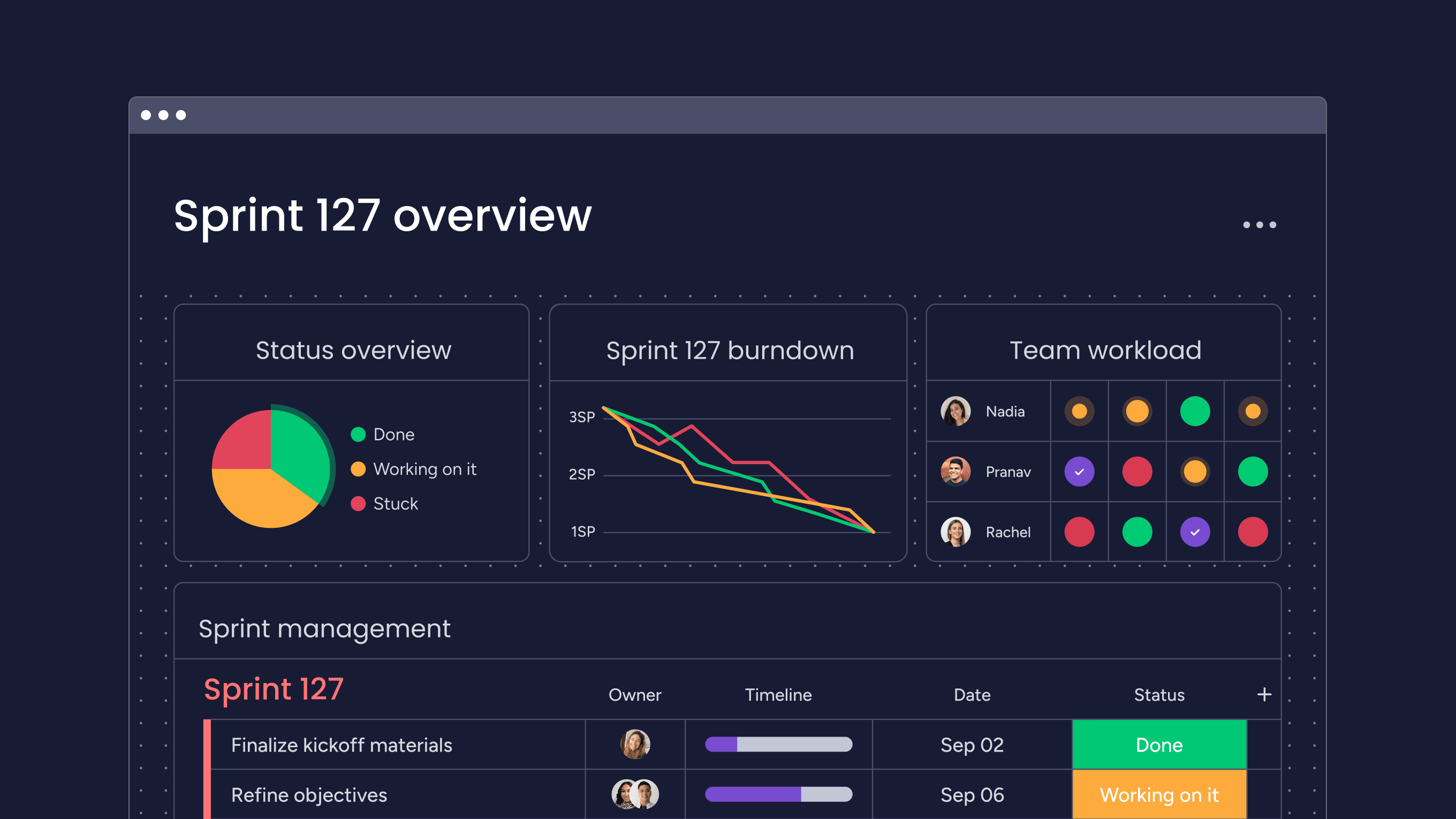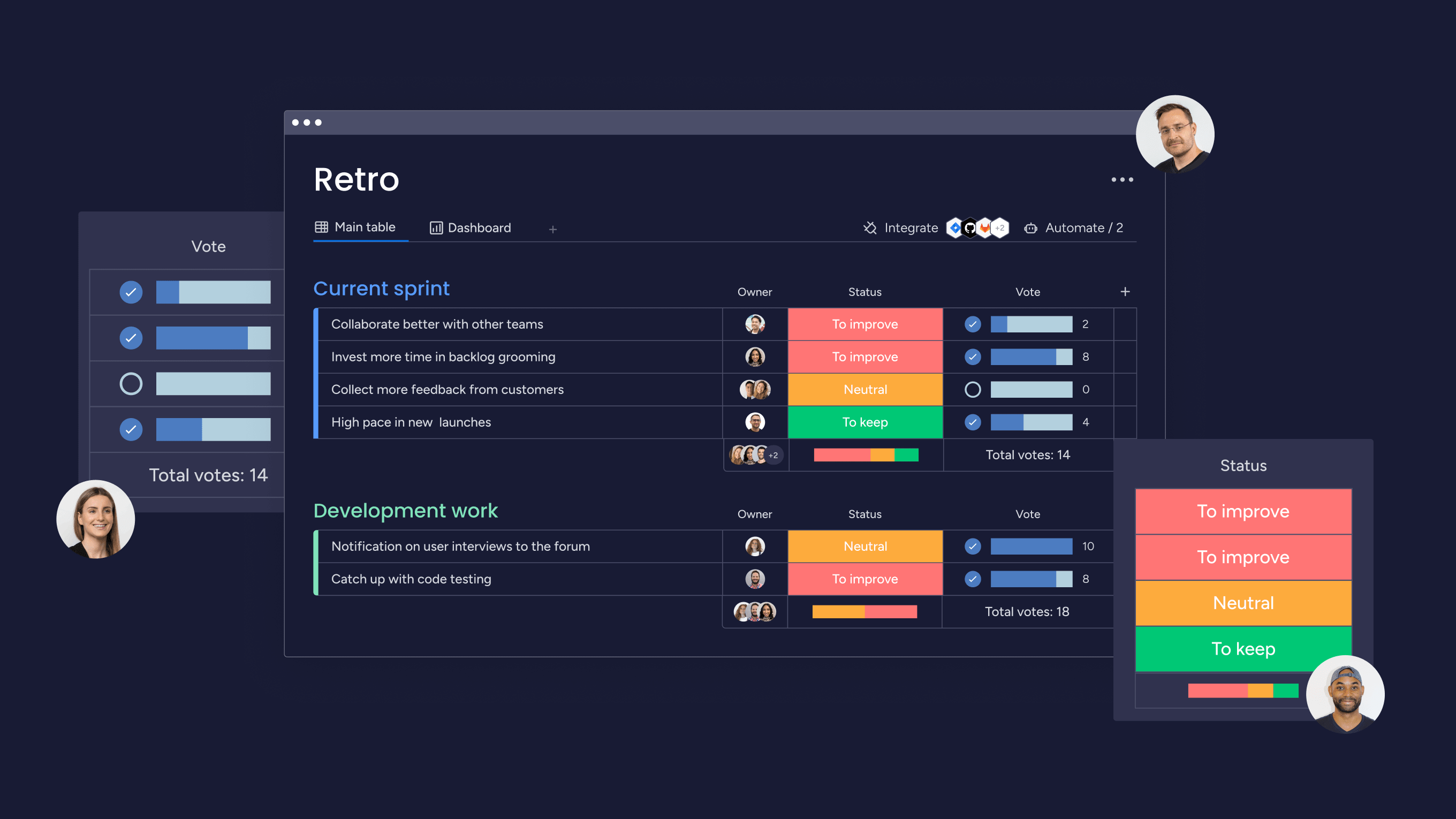Scrum meetings are an essential part of the Scrum framework.
In fact, according to the Agile Manifesto, development teams need to engage in face-to-face conversations to exchange information and react to changes quickly. And Scrum meetings are the best way to do that with your team members.
In this guide, we’ll examine the different types of Scrum meetings and highlight their purpose, duration, and attendees. Plus, we’ll show you how you can streamline your Scrum meetings with monday dev and set your Agile teams up for success. See here for an in-depth review of the agile and scrum frameworks.
Try monday devWhat are Scrum meetings?
Scrum meetings help teams, stakeholders, and management to stay aligned throughout a project.
If you’re unfamiliar with Scrum, it’s a framework based on the Agile project management methodology. One of the Agile principles states that development teams should have frequent in-person conversations (or even video conferencing for virtual teams) to exchange information and react to changes quickly. So, Scrum meetings are an essential part of the framework.
There are various types of Scrum meetings, such as Sprint Planning, Daily Stand-ups, and Sprint Reviews. Each meeting has a different agenda, but they all serve a similar purpose: to keep the team aligned, identify and resolve issues quickly, and continuously improve the product development process while following the Scrum framework.
Who attends a Scrum meeting?
Most Scrum meetings should include the entire team, while other stakeholders may attend some meetings as observers. A Scrum team is a small team of 10 or fewer people with three defined roles:
- Product owner: Controls the overall vision and objectives, liaises with stakeholders, and directs the team.
- Scrum master: Reinforces Scrum values during meetings, dictates the timelines, and keeps team members on-task.
- Developers (team members): Execute the agreed work from the sprint planning.
Based on the type of meeting, each Scrum team member plays a different role and participates differently.
What are the different types of Scrum meetings?
There are five different types of Scrum meetings. Here’s a breakdown showing the purpose of each meeting, how often it is needed, and who must attend/run it.
1. Sprint planning meeting
- When: Held at the start of each sprint.
- Attendees: The full Scrum team — product owner, Scrum master, and developers.
- Duration: They usually last about two hours for every week the sprint lasts. So, a two-week sprint would involve a four-hour planning session before work commences.
- Purpose: The team reviews the product backlog, sets the sprint goal, and plans the work for the upcoming sprint.
The product owner conducts the meeting before the start of every sprint, following the Sprint review and the Sprint retrospective for the previous sprint. They present the product backlog, identify or reiterate the company’s goals and desired outcomes, and answer any questions.
The development team looks at the product backlog tasks and predicts how much they can realistically deliver in the sprint. Time-boxing, or assigning a fixed and maximum amount of time for an activity, is a part of this process.
The work that the development team commits to is known as the sprint goal, and the collection of tasks that make up that goal is known as the sprint backlog. By the end of the meeting, the Scrum master ensures everyone agrees on the sprint’s scope.
2. Daily Scrum (or Stand-up) meeting
- When: Daily, typically first thing in the morning.
- Attendees: All Scrum team members — the product owner, Scrum master, and developers,
- Duration: No longer than 15 minutes.
- Purpose: A short daily meeting where team members share progress, identify blockers, and plan their work for the day.
The daily Scrum meeting — also known as the daily stand-up meeting — allows the team to review goals and address any potential bottlenecks. (Other stakeholders may attend but are there only to listen, not participate.)
As the name suggests, the meeting takes place standing up and should last at most 15 minutes. Many teams prefer to meet at the beginning of the day, but it can occur anytime as long as the duration remains consistent.
The Scrum master guides the meeting by asking three questions:
- What did you complete yesterday?
- What tasks are in the pipeline today?
- What is hindering the flow?
This ensures everyone is aligned on the day’s tasks.
3. Sprint review meeting
- When: At the end of a sprint.
- Attendees: All the Scrum team members, plus key stakeholders invited by the product owner.
- Duration: About an hour for every week of a sprint. So, a two-week sprint should be followed by a two-hour review session.
- Purpose: The team demonstrates the work completed and gathers feedback from stakeholders.
The development team leads the sprint review meeting at the end of every sprint and presents the work they accomplished to the entire Scrum team and often outside stakeholders.
The Sprint review — also known as the Sprint Demo — showcases the value the project brings to the company and demonstrates the new functionality. The stakeholders also provide feedback on the user stories implemented in the sprint. If that feedback is accepted, it’s added to a new product backlog, which is reviewed and prioritized during the next Sprint planning session.
4. Sprint retrospective meeting
- When: At the end of a sprint.
- Attendees: The whole Scrum team — product owner, Scrum master, and developers.
- Duration: Typically, 45 minutes per sprint week. For example, the average length of a Sprint retrospective would be 90 minutes for a two-week sprint.
- Purpose: The team reflects on what went well, what didn’t, and identifies areas for improvement.
Continuous improvement is a major part of the Scrum framework, and the sprint retrospective facilitates this by reflecting on the previous sprint, and addressing:
- What went right
- What went wrong
- What teams could do differently to improve collaboration in the future
No one outside the Scrum team attends these meetings, as they could hinder the open communication needed. During the meeting, the team can constructively criticize various elements of the sprint without assigning blame to other members to help the team work better in their subsequent sprints.
5. Backlog refinement meeting
- When: Before the sprint planning meeting.
- Attendees: The product owner and some or all of the developers and Scrum master.
- Duration: No fixed time.
- Purpose: The team discusses and prioritizes items in the product backlog.
The backlog refinement meeting — also known as “product backlog grooming” — allows Scrum teams to review and organize the product backlog to ensure it contains appropriate, prioritized, and well-estimated items. During the meeting, they identify and remove irrelevant items, create new items, re-prioritize, and split large items into smaller ones.
Unlike the time-boxed sprint planning and sprint retrospective meetings, backlog refinement is an ongoing process and meetings can take place as often as needed.
Try monday dev5 top tips for holding effective Scrum meetings
Here are the best practices to help you get the most out of your Scrum meetings.
- Begin and end meetings on time. To promote efficiency and productivity, start meetings promptly and end them at the scheduled time, even if all participants are not present.
- Ensure meeting objectives align with sprint goals. To keep the meetings focused and valuable, rank the meeting topics based on their priority and relevance to the current sprint and its objectives.
- Follow the recommended time frames. Adhere to the suggested time limits for each type of Scrum meeting, such as keeping daily stand-ups to 15 minutes or less.
- Prepare a meeting agenda and stick to it. Circulate a detailed agenda ahead of time to keep the discussion on track and address all relevant topics.
- Encourage participation and continuous improvement. Ensure all team members actively participate and share progress, blockers, and ideas. Reflect after each meeting on what went well and what can be improved.
By following these best practices, Scrum teams can ensure their meetings are efficient, productive, and aligned with sprint and project goals. And using the right platform to manage them will make your meetings even more effective.
How monday dev can help streamline your Scrum meetings
With monday dev, built on the robust monday.com Work OS, you have all the latest information at your fingertips in one collaborative platform. With multiple ways to visualize and manage your sprints, you can see what teams are currently working on and which tasks are in the backlog for refinement when running your Scrum meetings.
- Sprint management: From sprint planning and daily stand-ups to retrospective and sprint review meetings, manage the lifecycle of your sprints directly on monday dev.

- Burndown chart: Easily detect any potential problems or bottlenecks for Scrum meetings by comparing the actual remaining effort with the ideal progress in a Burndown chart.

- Sprint retrospective: Use the sprint retrospective board in monday dev to capture ideas in one place, keep track of what’s performing well and what isn’t, and vote on the strongest ideas for upcoming sprints.

- Sprint dashboard: Automatically populate custom dashboards with high-level and granular insights for smarter decision-making at your Scrum meetings.

Kick-start your Scrum meetings with our ready-made templates
Scrum meetings enable your Agile teams to operate efficiently and effectively by engaging in face-to-face conversation, reducing backlog, and achieving goals.
Visual planning templates let you lay the groundwork for your projects and Scrum meetings in minutes. They’re also customizable, so you can tailor them to suit your specific needs. That way, you can spend less time planning the logistics of your Scrum meetings and more time focusing on what matters — setting your Agile teams up for success.
Start using monday dev today and see how easy it is to plan and run your Scrum meetings with the help of our interactive, drag-and-drop templates, like the Sprint retrospective template.
Scrum Meeting FAQs
What does Scrum stand for?
Although people assume Scrum is an acronym, it doesn’t actually stand for anything. The term comes from the sport of rugby, where a team comes together to move the ball forward. So, in software development, Scrum is where the team comes together to move the product forward.
What are the 5 Scrum ceremonies?
The five Scrum ceremonies refer to the five Scrum meetings: Sprint Planning, Daily Scrum, Sprint Review, Sprint Retrospective, and Product Backlog Refinement.
What are the 3 Scrum questions?
The three Scrum questions refer to the questions posed in the Daily Scrum (or Stand-up) meeting:
(1) What did you do yesterday?
(2) What will you do today?
(3) What is blocking your progress?
 Try monday dev
Try monday dev 
